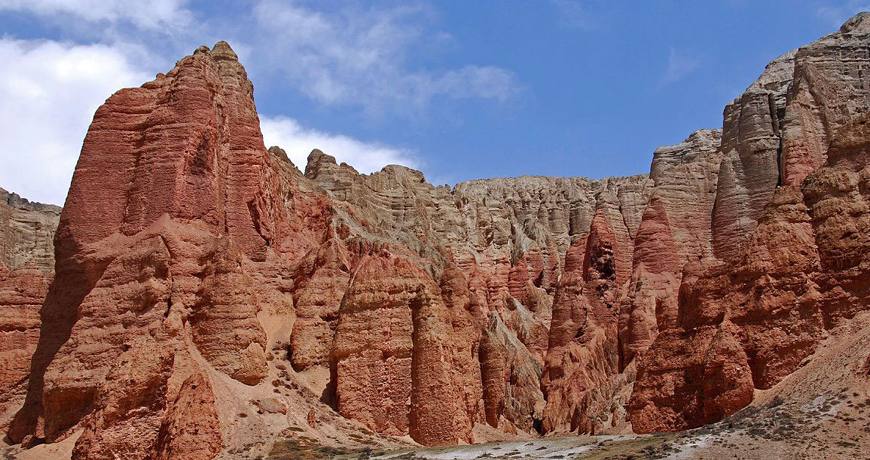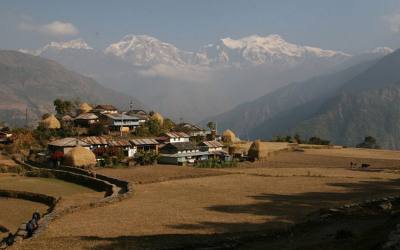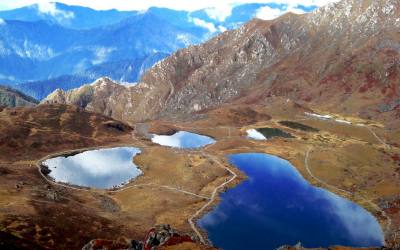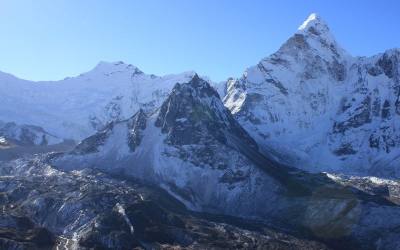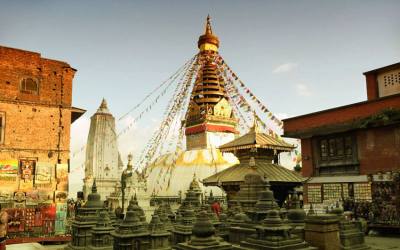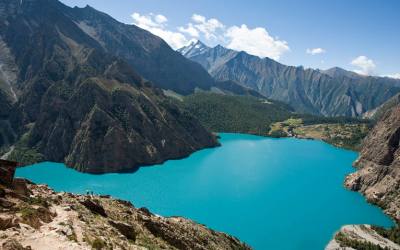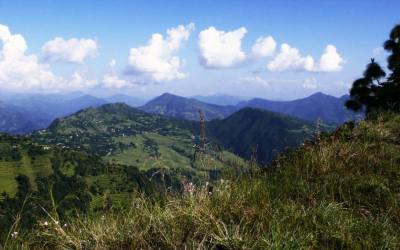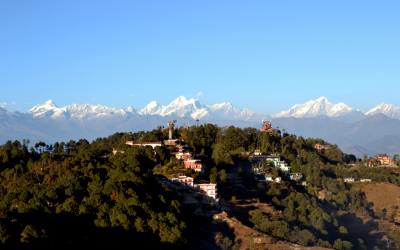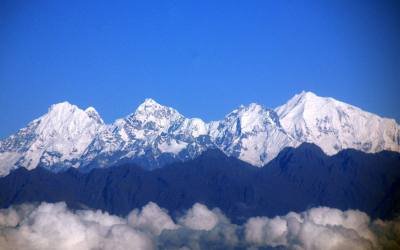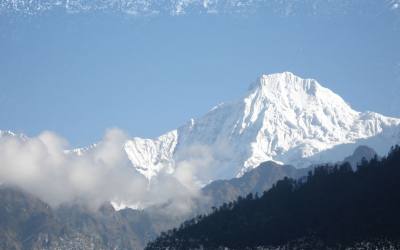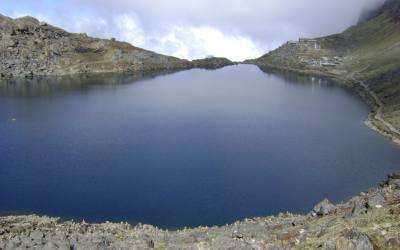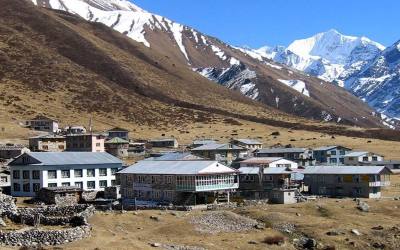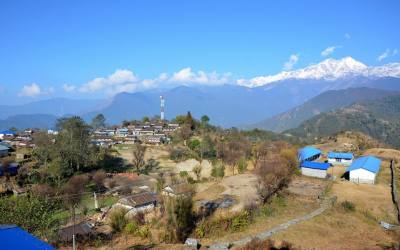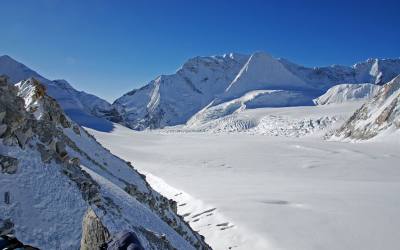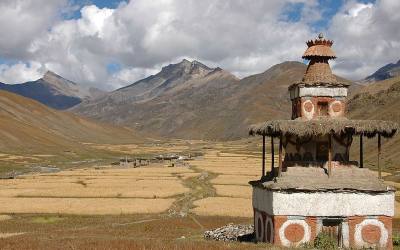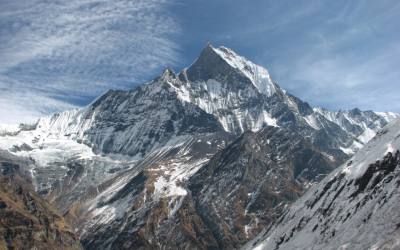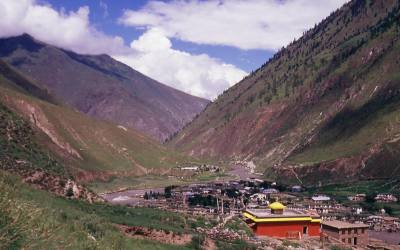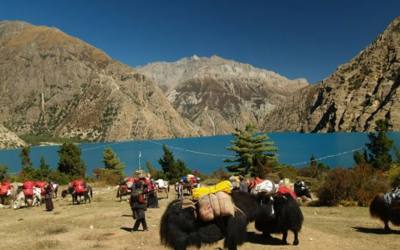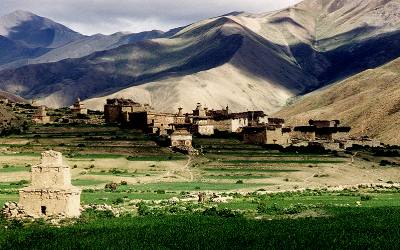Mustang valley is situated in the north of Annapurna himal and it is bordering to Tibetan plateau(China). It is used to be called Mustang kingdom. It was founded in the 15th century by a Tibetan monarch who consolidated various small local fiefdoms into the Kingdom of Lo. Though it was eventually incorporated in to Nepal. Mustang has remained isolated .its reputation as wild country was reinforced by the Tibetain guerilla fighters who sheltered here in the 1960s to make daring raids on the Chinese across the border .Following their expulsion by Nepalese army troops in the early 1970s. Even after it was included in the Nepalese territory , entry was tightly rusticated for foreigners. In 1992, Nepalese government declared the opening of Mustang. It is still fresh in people’s memory. During the trekking on this course, you will be visiting villages that are still retaining old Tibetan culture in a desolate desert area. It is one of the very different trekking in Nepal.
Flora and Fauna
The range of geographical and climatic regions has led to a diverse variety of flora and fauna with in the Annapurna region. these parts of area are heavily cultivated and the landscape is terraced paddy fields for most of the year.the higher up in the hills the natural vegetation changes from the tropical species to more temperate stands of forest trees including oak, beech and rhododendron.
People and culture
The most prominent ethnic groups in the annapurna region are the Gurung, Braman, chetri, Thakali and the Manangba.
Upper Mustang
To trek into upper mustang is a rare privilege. Here you will experience the way of life of the true mountain people, for years, cut off from the rest of Nepal. In many ways, a trek into upper mustang is similar to trekking into Tibet, which geographically it is a part of. The district of Mustang was, until 1950, a separate kingdom within the boundaries of Nepal. The last king, the raja of mustang, still has his home at the ancient capital, Lo Manthang.
Access to upper Mustang has only been possible for non-Nepalese trekkers for around ten years and, even today, access is still heavily regulated and restricted. To enter upper Mustang, that is to travel further north than Kagbeni, trekkers need a special trekking permit and mist be accompanied by a government appointed environmental officer. The expenses of the environmental officer have to borne by the group. Trekker must have arranged their trek through a government recognized trekking agency in order to be issued permits. The cost of the trekking permit is US$700 per person for ten-day trek in the restricted area.
Upper Mustang, being in the Himalayan rain shadow, is one of the few parts of the country that are suitable for trekking during the summer monsoon period. Even at this time, the upper kali Gandaki valley is still quiet dry with only occasional rainfall. The Mustang trek is not particularly difficult, the highest point reached is only 3800 meters, but the conditions at times can be arduous. Cold in winter and windy and dusty all year. Winter treks are best avoided due to southern parts of the country and even India.
There are few accommodation facilities available above Kagbeni so groups must be fully self-sufficient, especially in fuel. While porters are available in Jomsom it is preferable, in Mustang, to use mules to carry the loads. These pack animals are available locally and are more economical, and certainly more environmentally friendly, than human porters.
The Mustang trek requires a minimum of nine days starting and ending in Kagbeni. This allows the trek to be completed within the ten-day permit period. The route basically follows the kali Gandaki valley but, on occasions, climbs high above the valley walls. The settlements are scattered with little sign of cultivation between villages. In Mustang, little will grow without irrigation, which makes the settlements reminiscent of oases.
Lo Manthang, the old capital, is reached in four days and at least one extra day should be spent here for local sight-seeing. Ponies are available for hire for this purpose.
The return trip can either follow the upward route or, for an alternative, the eastern bank of the kali Gandaki may be followed.
Day 01: Arrival and Transfer to Hotel in kathmandu
Day 02: Free day in Kathmandu or self visiting around valley
Day 03: Early in the morning take a bus ride to Pokhara or by air
Day 04: Early in the morning flight to Jomsom than trek to Kagbeni for 3hours (2776m)
Day 05: Kagbeni – Chuksang(2950m)
Day 06: Chuksang- Samar(3490m)
Day 07: Saamar-Gheling(3590m)
Day 08: Gheling- Tsarang(3580m)
Day 09: Tsarang- Lo Manthang(3760m)
Day 10: Rest day and explore the surroundings of Lo Mangthang
Day 11: Lomathang- Lo Gekar(3880m)
Day 12: Le Gekar- Ghami(3550m)
Day 13: Ghami- Samar(3490m)
Day 14: Samar- Kagbeni
Day 15: Kagbeni- Jomsom
Day 16: Jomsom to Pokhara by air
Day 17: By bus to Kathmandu.
Day 18: Free Day in Kathmandu or self sight seeing around valley
Day 19: Tour Ends ( Departure for onwards destination)
Day 1 –Arrival and Transfer to hotel in Kathmandu.
Upon arrival in Kathmandu. Our airport representative will be waiting outside the airport terminal a few metres from the exit door. Please check your name at play card. He will bring you to hotel in kathmandu. The drive from the airport to the hotel is around 20 minutes
Day 2 –Free day in Kathmandu or self sight seeing tour (option are)
Hanumandhoka ( Kathamdnu Durbar Square ):
It is the historic seat of royalty. The Durbar Square , with its old temples and palaces, epitomizes the religious and cultural life of people. It is here that kings of Nepal are crowned and their coronations solemnized. Interesting things to see here are, Taleju temple built by king Mahendra Malla in 1954 AD, the temple of Kal Bhairab , the god of destruction, Nautale durbar, the statue of King Pratap Malla, the big drum and the Jaganath temple. It was listed in the UNESCO world heritage monument list in 1979.
On the right hand corner, a large wooden lattice screen hides an enormous gilded face of Sweta Bhairab. The screen is removed only during the Indra Jatra festival.. there are also the Numismatic museum and Tribhuban museum inside the Hanuman Dhoka palace building . Photography is prohibited inside the museums. Both the mseums remain closed on Tuesday and government holidays.
Swoyambhunath ( Monkey temple)
This is one of the world’s most glorious Buddhist Chaityas. It is said to be 2,000 years old. Painted on the four sides of the spire’s base are the all seeing eyes of Lord Budhha. It is 3Km west of Kathmandu city and it situated on a hillock about 77 m commands an excellent view of the Valley. This stupa is the oldest of its kind in Nepal . It was listed in the UNSCO world Heritage Monument List in 1979.
Day 3 - Pokhara (850m) By Tourist bus to Pokhara or by air
The bus journey will take approx 7 hours but by air it takes only 35minates.
Pokhara is set in a lovely valley at the foot of the Machapuchare so you get spectacular views of the mountains from all parts of the town. It is quite different from Kathmandu, with few temples, but it does have plenty of scenic attractions and is close to the mountains. There are some interesting short walks or bicycle rides from Pokhara, you can swim and canoe on Lake Phewa or just watch the last rays of the sun stream across the dip in the mountains that hold the lake. Along the lakeside road there is a continuous stretch of small hotels, restaurants and shops; it’s an area which still has a bit of the old hippy scene feel about it.
Day 4 - Kagbeni (2776m)
(Flight time: approx 25 mins; trekking approx 3 hours) Weather permitting the flight from Pokhara to Jomsom leaves early in the morning and is perhaps the most exciting flight in Nepal. There are fantastic views as we fly up the Kali Ghandaki Gorge, flanked on either side by the Himalayan giants of Annapurna 1 (8091m) and Dhaulagiri (8167m). Our trekking crew will already be in Jomosom (2715m), awaiting our arrival. We begin the trek from the airport on the west bank of the KaliGhandaki River before quickly crossing to the east bank and into the main part of Jomsom. The walking is easy as we follow the Kali Ghandaki through barren, windswept trans-Himalayan scenery. This is our first day at altitude so a relaxed pace is recommended. After just over two hours we reach the few houses of Eklabhatti, where the main trail ascends to Muktinath (3880m).
We bear left and continue up the valley to the small village of Kagbeni, which marks the beginning of the restricted zone.
Day 5 - Chuksang (2950m)
(Trekking: approx 6 hours) Before leaving Kagbeni we have to complete special permit formalities as we enter the restricted zone. The trail then climbs above the village and continues on a series of short ascents and descents on the east bank of the Kali Ghandaki. Whilst the valley floor is a flat river plain, it cannot be followed due to the number of river crossings that would need to be made. On the west bank we soon see the Gompa Kang Monastery, belonging to the Nyingmapa sect. The high trail that disappears into the barren distance leads to the Dolpo region. The first village from Kagbeni is Tangbe (2940m), located above the valley and identified by a trio of black, red and white chortens (Buddhist shrines). The village itself is a maze of whitewashed, flat- roofed houses linked by narrow alleyways. We take lunch close to the village near fields of buckwheat and apple orchards. The afternoon walk is shorter and we should reach Chuksang in a further two hours. Again we follow the east bank until we reach the confluence of Narshang Khola and the Kali Ghandaki. The village is split into three sections and the remains of an old fort can be seen close by. The scenery is totally unlike the traditional views one sees of Nepal; here the terrain is barren and very similar to that associated with Tibet. From our camp, huge red and orange sculptured cliffs with inaccessible caves dominate the opposite side of the valley.
Day 6 - Samar (3490m)
(Trekking: approx 6 hours) There are five villages in this immediate area linked by ethnic ties - Chele, Gyakar, Chuksang, Tangbe and Tetang. They are related to the people of the Manang Valley rather than those from Jomsom and Kagbeni or Lo Manthang. It is a tough existence for people in this area - arable land is limited and trading is necessary to supplement any income made from the soil. The morning walk follows the riverbed before crossing the Kali Ghandaki on a steel suspension bridge close to the place where the river passes under a huge block of red sandstone. From here there is a steep ascent to the village of Chele, where we take lunch close to barley fields and nearby willow trees. In the afternoon we climb again to a cairn at 3130 metres. Here we witness views of the village of Gyakar, lying across an impressive canyon where a patchwork of green fields gives a dash of colour to the barren terrain. The trail which is narrow in places continues to ascend to a pass at 3550 metres. To the south great views of the Himalayan peaks can be enjoyed including Nilgiri and Tilicho peaks. From the pass it is a short descent to the village of Samar and our camp close to a willow grove and irrigation channels.
Day 7 - Gheling (3590m)
(Trekking: approx 4 hours) From the village we descend steeply past a red, black, yellow and white chorten nearly 60 metres into a deep ravine before inevitably climbing out and descending again into another canyon. We then ascend and continue our climb through an area of shrub juniper. It takes nearly two hours to reach a small ridge at 3750 metres after which a short descent leads to a couple of tea houses at Shangmochen and a welcome break. We ascend again to reach another pass at 3770 metres, where we enter a huge east-west valley. Here we bear to the right and drop down to Gheling, where we make camp close to the extensive barley fields. It is a long morning’s walk, but we have kept the afternoon free to assist with our acclimatisation.
Day 8 - Tsarang (3580m) (Trekking: approx 7 hours) We begin the morning by ascending gently through the fields up the valley, passing below the settlement of Tamagang and a large chorten. We rejoin the main trail and begin another steep climb to the head of the valley to Nyi La (3930m). We are now at the border of Mustang and descend gradually for half an hour to meet a trail junction. The right fork heads to Charang and our track bears to the left towards Ghami (3250m) where we take lunch. In the afternoon the track crosses a river gully before ascending to a plateau and mani wall where we head east, climbing above the village of Tramar to a ridge at 3770 metres. From here it is a gradual descent to Tsarang, a large and fertile village populated by people form Mustang - the Lobas. The village has a magnificent monastery.
Day 9 - Lo Manthang (3760m)
(Trekking: approx 5 hours) After spending part of the morning exploring Tsarang, we descend from the village into the Tsarang River canyon before ascending a stony trail heading north, with fine views behind us of the Nilgiri, Tilicho and Annapurnaranges to the south. The trail passes an isolated chorten and spectacular caves etched into the surrounding cliffs, before reaching a ridge at 3850 metres for our first views of Lo Manthang and the spectacular scenery of the Mustang Khola and the snow-capped peak of Mansail in the west. From the ridge we descend to a small river and climb briefly to enter the fabled walled city from the north-eastern corner.
Day 10 - Lo Manthang (3760m)
(Exploration day) The ’city’ contains around 150 houses and four monasteries, one of which is reported to date back to the 15th century. Inside the temples we are able to view many Buddha images and religious paintings. Photography is sometimes not permitted and you should beware of the fierce Tibetan mastiff dogs that guard the monasteries. The city itself has declined since the Chinese invasion of Tibet. Prior to this, Lo Manthang was a centre for the old salt and wool trade and at one time was a prosperous city. The dominant building in the centre of the city is the King’s Palace. The Royal Family are descendants of an aristocratic family from Lhasa in Tibet and today, though their duties are largely ceremonial, the King is a well-respected horseman and breeder of Lhasa apso dogs. After exploring the city in the morning we may take an optional walk towards Chosar in the afternoon.
Day 11 - Lo Gekar (3880m)
(Trekking: approx 5 hours) Our return route has a few variations from the approach. The trail to the interesting monastery at Lo Gekar follows a minor path, away from the major route. We follow herders’ tracks up to a pass with final views of Lo Manthang before crossing into another valley and climbing to the valley head at 4050 metres. A further ascent and descent across two more valleys leads to a steep ascent and descent to the fertile valley and the monastery at Lo Gekar.
Day 12 - Ghami (3550m)
(Trekking: approx 5 hours) From the monastery there are views of the two neighbouring villages of Marang and Charang. We begin the day with a climb to a pass marked with a cairn at 4100 metres. The trail then passes through alpine meadows before twisting down a red and purple eroded gully to the village of Tanmar. We pass through lush fields that are a stark contrast to the surrounding barren terrain and climb a further ridge that precedes a short descent to the village of Ghami (3440m). The village has a monastery but is off limits to tourists following the theft of religious artefacts some years before. We move beyond the village and make camp further up the trail en route to the Nyi La (Nyi Pass).
Day 13 - Samar (34900m)
(Trekking: approx 5-6 hours) From the camp we ascend to a ridge marked by a cairn and then continue to climb until we meet the trail that comes from Tsarang. We head to a pass and then descend steeply into Gheling Valley, where we rejoin the trail used on our approach. We retrace our steps back to Samar with a final steep climb to the campsite.
Day 14 - Kagbeni (2860m)
(Trekking: approx 6-7 hours) We retrace our steps back to Kagbeni. As we are walk in the opposite direction, it is difficult to imagine we travelled this route just over a week before.
Day 15 - Jomsom
(Trekking: approx 4 hours) We retrace our steps through a barren, almost moon-like landscape dotted with patches of green cultivation. Man-made canals cut across the terrain, irrigating the crops and fruit trees. We lunch at Eklaibhati. Heading south, the wide, windswept valley floor has little fertile land, which means a hard existence for the inhabitants of the Upper Kali Gandaki. After a few hours following the valley downstream we arrive back at Jomsom, a dusty and windswept town where we spend the night in a lodge to await our flight back to Pokhara the following morning.
Day 16 - Pokhara (850m)
(Flight time: approx 30 mins) We rise early in the morning for the return flight to Pokhara where we return to the lakeside. After a welcomed shower, we have the rest of the day free to relax or do some exploring. There are various small museums scattered around town including the renowned International Mountain Museum.
Pokhara is a remarkable place of natural beauty. Situated at an altitude of 827m from the sea level and 200km west of Kathmandu valley, the city is known as a center of adventure with several beautiful lakes and offers stunning panaromic views of Himalayan peaks.
The serenity of lakes and the magnificence of the Himalayas rising behind them create an ambience of peace and magic. So today the city has not only become the starting point for most popular trekking and rafting destinations but also a place to relax and enjoy the beauty of nature.
Pokhara is part of a once vibrant trade route extending between India and Tibet. To this day, mule trains can be seen camped on the outskirts of the town, bringing goods to trade from remote regions of the Himalaya. This is the land of Magars and Gurungs, hardworking farmers and valorous warriors who have earned worldwide fame as Gurkha soldiers. The Thakalis, another important ethnic group here, are known for their entrepreneurship.
The climate of Pokhara is slightly warmer than Kathmandu with daytime temperature hovering around 15 degrees Celsius in winter and 35 degrees in summer. The monsoon season which lasts from mid-June to mid-September is very wet; in fact Pokhara records the highest rainfall in the country. Best time to visit is between October and April.
The activities of foreign visitors to Pokhara focus around two districts known as Damside and Lakeside (or Pardi and Baidam, in Nepali, respectively). These two areas, with their strips of hotels and restaurants, are a few kilometers south-west of the main Pokhara bazaar. More
Sarangkot
The view of the Annapurna Himalaya from Sarangkot is almost a religious experience. From here, you can see a panoramic sweep of Himalayan peaks, from Dhaulagiri (8167m) in the west to the perfect pyramid that is Machhapuchhare (6997m) and the rounded peak of Annapurna II (7937m) in the east. Most people come here at dawn or dusk, when the sun picks out the peaks in brilliant colours.
Fewa lake
Fewa Lake, the second largest lake in the Kingdom, is the center of attraction in Pokhara. It is the largest and most enchanting of the three lakes that add to the resplendence of Pokhara.
Mahendra cave
Another of nature’s wonders in Pokhara is the Mahendra Gupha. This large limestone cave is locally known as the House of Bats, an apt name for it. A two-hour walk to the north of Pokhara, it is best to bring your own torch to see the stalactites and stalagmites, as well as the local winged residents.
Seti River
Another of Pokhara’s natural wonders that unfailingly interests visitors is the Seti river. Flowing right through the city, this river runs completely underground at places. Amazingly, at certain points the river appears hardly two meters wide. But its depth is over 20 meters! Mahendra Pul, a small bridge near the old MissionHospital, provides a perfect view of the rivers’s dreadful rush and the deep gorge made by its powerful flow.
Barahi Temple
The Barahi temple is the most important monument in Pokhara. Built almost in the center of Phewa Lake, this two-storied pagoda is dedicated to the boar manifestation of Ajima, the protectress deity representing the female force Shakti. Devotees can be seen, especially on Saturdays, carrying male animals and fowl across the lake to be sacrificed to the deity.
Museum
The Pokhara Museum, located between the bus stop and Mahendra Pul, reflects the ethnic mosaic of western Nepal. The lifestyles and history of ethnic groups such as the Gurung, Thakali and the Tharu are attractively displayed through models, photographs and artifacts. One major attraction is a display highlighting the newly-discovered remains of an 8000-year-old settlement in Mustang.
Open daily, except Tuesdays and holidays, from 10 am to 5 pm
Devi’s Fall
Locally known as the Patale Chhango (Hell’s Fall). Devi’s Fall (also known as Devin’s and David’s) is a lovely waterfall lying about two km south-west of the Pokhara airport on the Siddhartha Highway. Legend has it that a trekker (Devin, David..) was washed away by the Pardi Khola and disappeared down into an underground passage beneath the fall.
Day 17 –By tourist bus or by air to Kathmandu
The bus journey will take approx 7 hours and by air it takes only 35 minates.
Day 18 – Free day at Kathmandu or self sight seeing tour (option are)
Bhaktapur durbar Squares:
The Golden Gate is the entrance to the main courtyard of the Palace of 55 Windows, built by King Ranjit Malla. The gate is one of the most beautiful and richly carved specimens of its kind in the entire world. This gate is embellished with deities and monsters with marvelous intricacy. The palace of 55 Window was built in 1700 AD. Among the brick walls in their gracious setting and sculptural design, is a balcony of 55 windws. This balcony is a masterpiece of wood carving. The stone temple of Batsala Devi which is also
located in the Durbar Square is full of intricate carvings. This temple also sets a beautiful example of Shikhara style architecture in Nepal . There is a bronze bell on the terrace of the temple which is also known as the Bell of Barking Dogs. This colossal bell, placed in 1737 AD, used to ring to signal curfew those days. The main square of the city contains innumerable temples and other architectural showpieces like the Lion Gate, the statue of King Bhupatindra Malla, the Picture Galley, the Batsal Temple , etc. A magnificent statue of King Bhupatindra Malla in the act of worship is placed on the column facing
the palace. It was listed in the UNESCO World Heritage Monument list in 1979.
Patan
The ancient city of Patan , lying 5 km southwest of kathmandu, is known as the city of fine arts, The city is full of Hindu temples and Buddhist monuments. The diversity of the medieval culture that allowed both Hinduism and Buddhism to flourish has left a rich legacy of impressive sightseeing in this city for today’s visitors.
Patan Durbar Square:
Situated in the heart of the city, constitutes the focus of visitor’s attraction. The square is full of ancient palaces, Temple and shrines, noted for their exquisite carvings. The Patan durbar Square consist of three main chowks or countryards, the Central Mul Chowk, Sundari Chowk and Keshar narayan Chowk, The Sundari Chowk holds in its center a masterpiece of stone architecture. The Royal Bath called Tushahity. It was listed in the UNESCO world Heritage Monument list in 1979.
Krishna Mandir:
Built in 1637 AD, the temple of Lord Krishaa holds a commanding position in the palace complex of Patan. It is supposed to be the first specimen of Shikhara style architecture in Nepal . It is the only temple in Nepal having 21 spires and is completely 21 spires and is completely mad of stone.
Boudhanath stupa
Boudhanath Stupa (or Bodnath Stupa) is the largest stupa in Nepal and the holiest Tibetan Buddhist temple outside Tibet . It is the center of Tibetan culture in Kathmandu and rich in Buddhist symbolism. The stupa is located in the town of Boudha , on the eastern outskirts of Kathmandu .
History
Bodnath was probably built in the 14th century after the Mughal invasions; various interesting legends are told regarding the reasons for its construction. After the arrival of thousands of Tibetans following the 1959 Chinese invasion, the temple has become one of the most important centers of Tibetan Buddhism. Today it remains an important place of pilgrimage and meditation for Tibetan Buddhists and local Nepalis, as well as a popular tourist site.
Pashupatinath Temple :
Situated 5km east of kathamandu, the temple of Lord Shiva , Pashupatinath, with two tired golden roof and silver door is considered one of the holiest for Hindus. Although only Hindus are allowed inside the temple, visitors can clearly see the temple and the activites performed in the Temple premises from the eastern bank of the Bagmati river. The Temple was listed in the UNESCO world heritage Monument List in 1979
Day19: Tour Ends ( Departure for onwards destination)
Price of this tour are on the request
Hotel we use in this tour
Kathmandu Prince Hotel
Thamel, Chhetrapati, kathmandu, Nepal
Tel : 4255961, 4255282, Fax : 977-1-4255282
E-Mail : [email protected]
Website : www.kathmanduprincehotel.com
Or
Potala Guest House
Thamel, chetrapati, Kathmandu
Tel : 4226566, 4220467
Email: [email protected]
Website : www.potalaguesthouse.com
Or
Hotel Marsyandi Mandala
Thamel, Chhetrapati, Dhobichour, Kathmandu, Nepal
Tel: 4254511, 4256063,
Fax: 977-1-4254275
Email: [email protected]
http://www.marsyangdimandala.com
Hotel we use in Pokhara
Pokhara village Resort
Lakeside, Pokhara, Nepal
Phone: 061-462427
Email: [email protected] or [email protected]
www.pokharavillage.com
Or
Hotel Kantipur
VIP Area Lake -Side Pokhara, Nepal
Post Box: 124
Tel: 00977-061-460286, 464705, 464806
Fax: 977-61-461004
E-mail: [email protected] E-mail: [email protected] , [email protected]
Web Site: www.hotelkantipur.com
What’s Included
- Airport Pickup and Drop by private transport
- All the ground Transportation by bus
- 4 nights hotel in Kathmandu & 3 nights hotel in Pokhara at tourist standard hotel ( Centrally located, Attach bathrooms, hot and cold shower)
- 11nights 12 days trekking in tent ( some time we also use lodge during the trek, lodges are simple and clean enough)
- All the meal during the trek (Breakfast, Lunch, Dinner)
- Special permit for Mustang valid for 10 days.
- Trekking map for Mustang valley
- Annapurna national park permit with TIMS card ( we need 3 photos for permit)
- All the camping equipment such as sleeping tent, Dinning tent, kitchen tent, Toilet tent, sleeping mattress, Sleeping Bag, Kitchen Equipment etc.)
- An experience trekking guide (trained by Ministry of tourism), Trekking cook, kitchen helper, sherpa and necessary number of porter’s , their meal/accommodation/transportation/salary/insurance/equipments are included in price.
- Demostic Airfare ( Pokhara - Jomsom / Pokhara and domestic airport tax,
What’s not Included
- Personal bar bill, travel insurance/International airfare/Domestic airfare.
- Items of personal expenses such as alcoholic drinks, cold drinks, laundry, tips etc.
- Nepal entry visa fee US$ 40 (duration 60 days from date of issue)- Available at Royal Nepalese Embassies and Royal Nepalese Consulates abroad or on arrival at Tribhuvan International Airport in Kathmandu.
- Sight seeing tour and All the entrance fees of temple in Kathmandu and Pokhara
